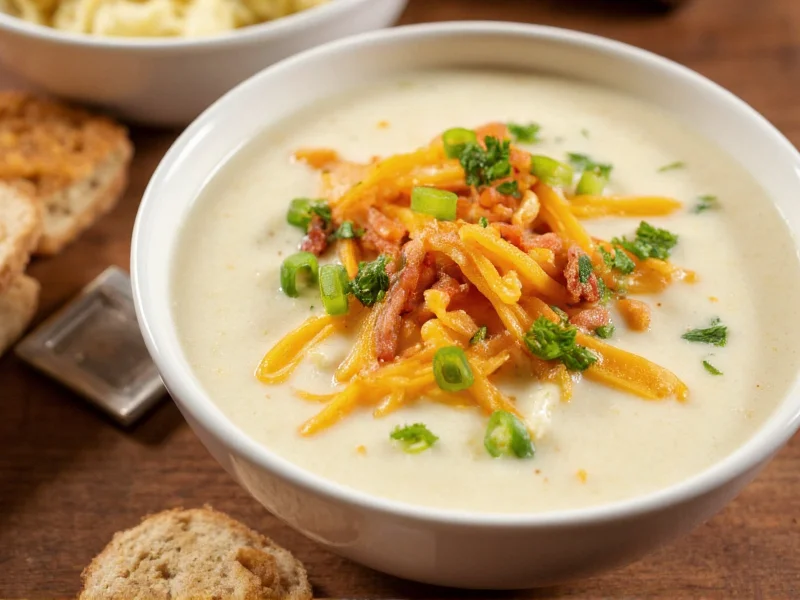The Essential Components of Authentic Loaded Potato Soup
Creating exceptional loaded potato soup starts with understanding what makes it distinct from basic potato soup. The “loaded” designation refers to the generous toppings and rich ingredients that transform a simple soup into a decadent meal. Unlike regular potato soup, which might contain just potatoes, broth, and basic seasonings, loaded versions incorporate multiple layers of flavor and texture.
Professional chefs emphasize that the foundation of the best creamy loaded potato soup recipe begins with properly cooked potatoes. Russet potatoes provide the ideal starch content for thickening, while Yukon Golds offer natural buttery flavor. Combining both varieties creates a soup with perfect body and taste. The cooking liquid should be a blend of chicken or vegetable broth with heavy cream or half-and-half for that signature richness without overwhelming heaviness.
Step-by-Step Preparation Guide
Follow this method for restaurant-quality loaded potato soup every time. The key to avoiding common issues like grainy texture or bland flavor lies in proper technique and ingredient sequencing.
| Ingredient | Quantity | Preparation Notes |
|---|---|---|
| Russet potatoes | 2 lbs, peeled | Cut into 1/2-inch cubes for even cooking |
| Yukon Gold potatoes | 1 lb, unpeeled | Adds creaminess; leave skin on for nutrients |
| Bacon | 6 slices | Crisp first; use rendered fat for cooking |
| Heavy cream | 1 1/2 cups | Add at the end to prevent curdling |
| Sharp cheddar | 1 cup, shredded | Use freshly grated for best melting |
Avoiding Common Preparation Mistakes
Many home cooks encounter issues when making loaded potato soup from scratch. The most frequent problems include:
- Grainy texture - Caused by overcooking potatoes or using low-moisture varieties. Maintain gentle simmer after adding potatoes.
- Broken dairy - Adding cold cream to boiling soup causes curdling. Temper dairy by gradually mixing in hot broth first.
- Bland flavor - Underseasoning is common. Season in layers: broth, during cooking, and final adjustment before serving.
- Watery consistency - Insufficient potato starch. Reserve some cooked potatoes, mash, and stir back in for natural thickening.
Perfect Pairings and Serving Techniques
Serving loaded potato soup properly enhances the entire experience. The ideal temperature range is 160-170°F - hot enough to keep toppings melty but not so hot that dairy separates. For the classic loaded presentation:
- Pour soup into pre-warmed bowls
- Sprinkle 2-3 tablespoons of shredded cheddar immediately
- Add crumbled bacon and sliced green onions
- Finish with a dollop of sour cream just before serving
Pair with crusty bread or a simple green salad for a complete meal. For special occasions, consider adding a small scoop of caviar or truffle oil for an elevated presentation that maintains the soup’s comforting essence.
Dietary Adaptations Without Compromising Flavor
Creating delicious loaded potato soup for various dietary needs requires smart substitutions rather than simple ingredient removal. For gluten-free versions, replace flour thickeners with cornstarch slurry or pureed cauliflower. Dairy-free alternatives work best when combining full-fat coconut milk with nutritional yeast for cheesy flavor.
Vegetarian adaptations maintain richness by using smoked paprika with mushroom broth to replicate bacon’s umami depth. The secret professional chefs use is to roast vegetables like carrots and celery before adding to the broth, which creates natural sweetness and complexity that compensates for missing meat elements.
Storage and Reheating Best Practices
Proper storage ensures your homemade loaded potato soup maintains quality. Cool to room temperature within two hours of cooking, then transfer to airtight containers. Refrigerated soup stays fresh for 3-4 days, while frozen portions last up to three months.
When reheating, add a splash of broth or cream to restore consistency, as potatoes continue absorbing liquid during storage. Never microwave loaded potato soup with dairy components already added - reheat the base soup first, then incorporate dairy and toppings. For meal prep convenience, store components separately: soup base, cheese, bacon, and garnishes in individual containers for perfect assembly anytime.
What’s the difference between loaded potato soup and regular potato soup?
Loaded potato soup features additional toppings and richer ingredients like bacon, cheese, sour cream, and chives that transform basic potato soup into a more substantial meal. Regular potato soup typically contains just potatoes, broth, and basic seasonings without the indulgent toppings that define “loaded” versions.
Can I make loaded potato soup without bacon?
Yes, you can create excellent vegetarian loaded potato soup by substituting bacon with smoked paprika, liquid smoke, or roasted mushrooms for umami depth. For similar texture, try tempeh bacon or coconut bacon alternatives that provide the crispy element without meat.
Why does my potato soup become watery after refrigeration?
Potatoes continue absorbing liquid as they cool and during refrigeration, which can make soup appear watery when reheated. To prevent this, slightly under-thicken your soup during initial preparation. When reheating, add a small amount of cream or broth to restore ideal consistency.
How can I make my loaded potato soup thicker without flour?
Create natural thickness by reserving 1-2 cups of cooked potatoes, pureeing them with some broth, then stirring back into the soup. Alternatively, blend in cooked cauliflower or white beans for added nutrition and body without altering the classic potato flavor profile.
What’s the best potato variety for loaded potato soup?
Combining Russet and Yukon Gold potatoes delivers optimal results. Russets provide starch for thickening while Yukon Golds contribute natural buttery flavor and creamy texture. Avoid waxy potatoes like red potatoes, which don’t break down sufficiently to create the desired soup consistency.











 浙公网安备
33010002000092号
浙公网安备
33010002000092号 浙B2-20120091-4
浙B2-20120091-4